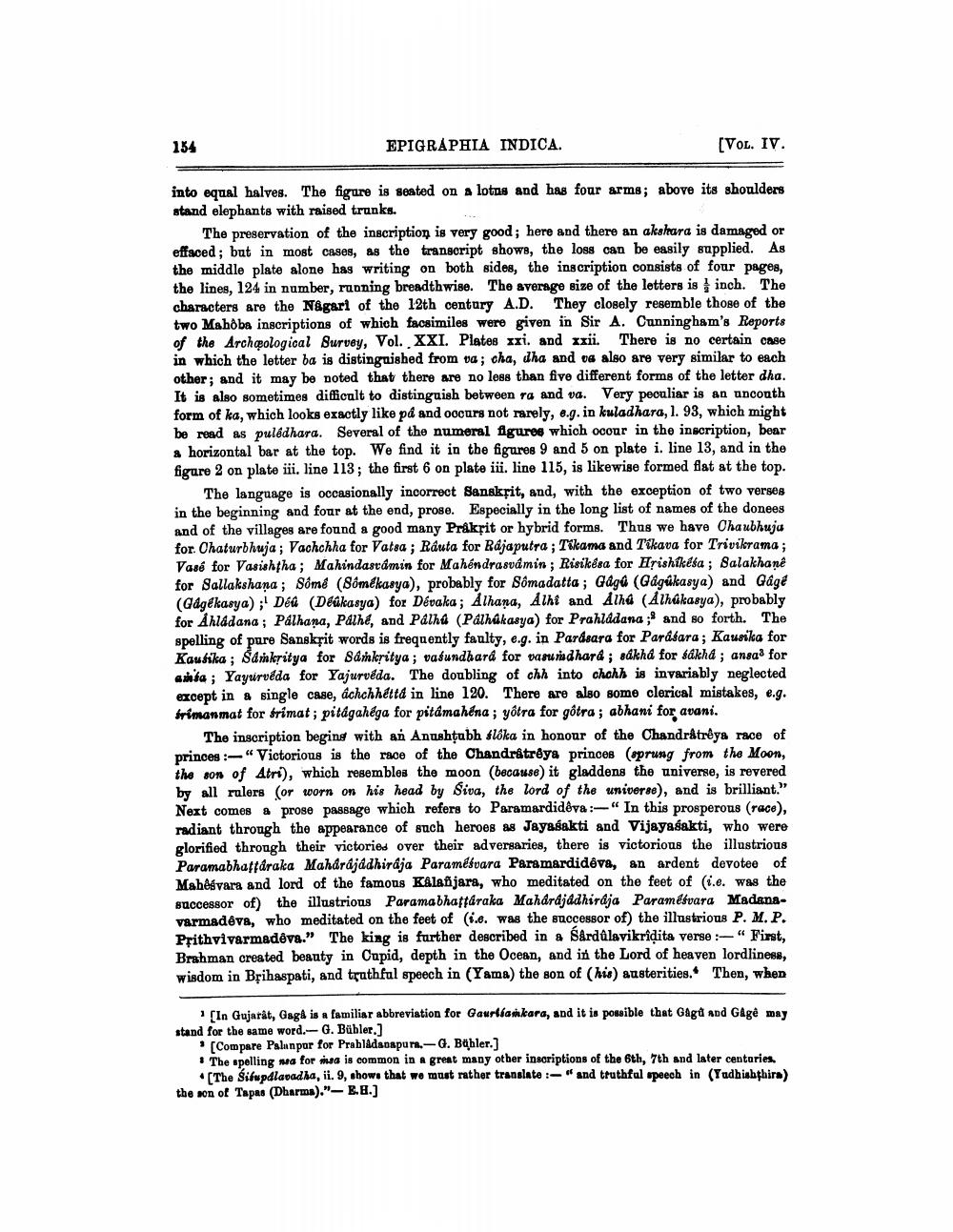________________
134
EPIGRAPHIA INDICA.
[VOL. IV.
into equal halves. The figure is seated on a lotns and has four arms; above its shoulders stand elephants with raised trunks.
The preservation of the inscription is very good; here and there an akshara is damaged or effaced; but in most cases, as the transcript shows, the loss can be easily supplied. As the middle plate alone has writing on both sides, the inscription consists of four pages, the lines, 124 in number, running breadthwise. The average size of the letters is inch. The characters are the Nagari of the 12th century A.D. They closely resemble those of the two Mahoba inscriptions of which facsimiles were given in Sir A. Cunningham's Reports of the Archeological Survey, Vol. XXI. Plates xxi. and xxi. There is no certain case in which the letter ba is distinguished from va; cha, dha and ve also are very similar to each other; and it may be noted that there are no less than five different forms of the letter dha. It is also sometimes difficult to distinguish between ra and va. Very poouliar is an unconth form of ka, which looks exactly like på and oocurs not rarely, e.g. in kuladhara, 1. 93, which might be read as pulédhara. Several of the numeral figures which ocour in the inscription, bear a horizontal bar at the top. We find it in the figures 9 and 5 on plate i. line 13, and in the figure 2 on plate iii. line 113; the first 6 on plate iü. line 115, is likewise formed flat at the top.
The language is occasionally incorrect Sanskrit, and, with the exception of two verseg in the beginning and four at the end, prose. Especially in the long list of names of the donees and of the villages are found a good many Pråkpit or hybrid forms. Thus we have Chaubhuja for. Chaturbhuja; Vachchha for Vatsa ; Rauta for Rajaputra; Tikama and Tikava for Trivikrama; Vase for Vasishtha; Mahindastámin for Mahendrasvámin; Risikêsa for Hrishikéta ; Balakhanê for Sallakshana ; Sømd (8ômékasya), probably for Somadatta; Gåge (Gágúkasya) and Gage (Gdgekasya) ;' Déd (Déukasya) for Devaka; Alhana, Alhi and Aiha (Athúkasya), probably for Aniadana; Palhana, Palhd, and Paina (Pathakasya) for Prahladana ;' and so forth. The spelling of pure Sanskrit words is frequently faulty, e.g. in Parásara for Parabara; Kausika for Kausika ; Sámiksitya for sanksitya; vasundhard for vasu riadhará ; sdkha for såkhd; ansa: for auhita : Yayurvéda for Yajurvéda. The doubling of chh into chohh is invariably neglected except in a single case, achchhéttà in line 120. There are also some clerical mistakes, e.g. frimanmat for frimat; pitágahéga for pitámahéna ; yotra for gôtra ; abhani for avani.
The inscription beging with an Anushtabh flóka in honour of the Chandr&trêya race of princes :-“ Victorious is the race of the Chandrätrêya princes (sprung from the Moon, the son of Atri), which resembles the moon (because it gladdens the universe, is revered by all rulers (or worn on his head by Siva, the lord of the universo), and is brilliant." Next comes & prose passage which refers to Paramardidêva :-" In this prosperous (race), radiant through the appearance of such heroes as Jayasakti and Vijayasakti, who were glorified through their victories over their adversaries, there is victorious the illustrious Paramabhaftáraka Maharajadhiraja Paramétuara Paramardidêva, an ardent devotee of Mabesvara and lord of the famous Kalanjara, who meditated on the feet of (i.e. was the successor of) the illustrious Paramabhattáraka Maharajadhiraja Paramétvara Madanavarmadeva, who meditated on the feet of (i.6. was the successor of) the illustrious P. M.P. Prithvivarmadova." The king is further described in a Sardůlavikridita verse - "First, Brahman created beauty in Capid, depth in the Ocean, and in the Lord of heaven lordliness, wisdom in Bțihaspati, and truthful speech in (Yama) the son of (his) austerities. Then, when
[In Gujarat, Gaga is a familiar abbreviation for Gaurliankara, and it is possible that Gaga and Gage may stand for the same word.-G. Bübler.]
[Compare Palunpar for Prabladaoapura.-G. Bähler.]
The spelling wa for ma is common in a great many other inscriptions of the 6th, 7th and later centuries.
• The Sifupdlavadha, il. 9, shows that we must rather translate :-"and truthful speech in (Yudhishthira) the son of Tapas (Dharma)."-E.H.]




